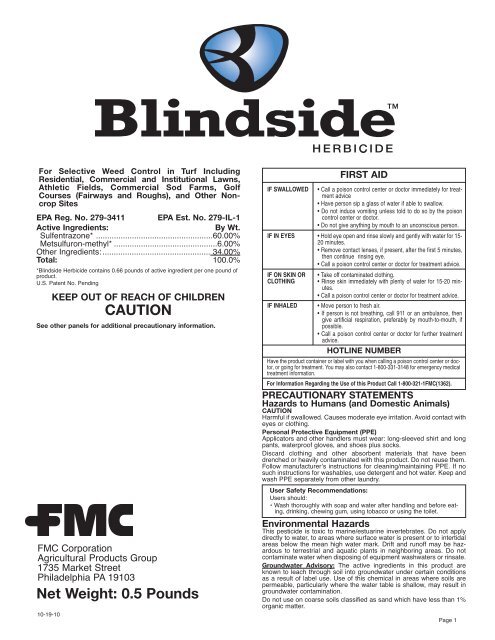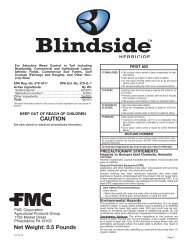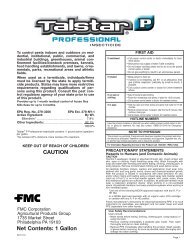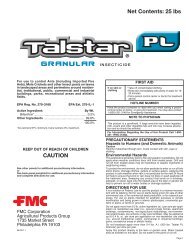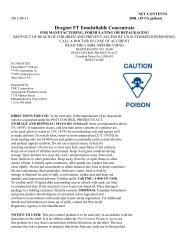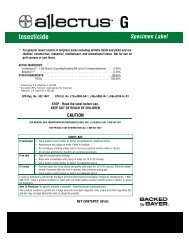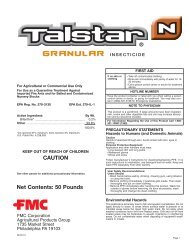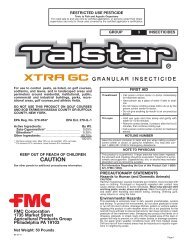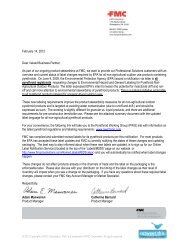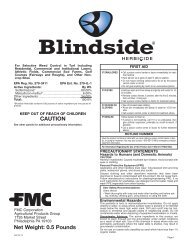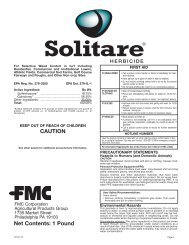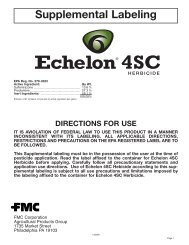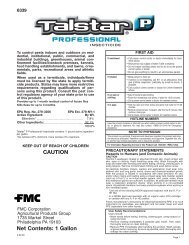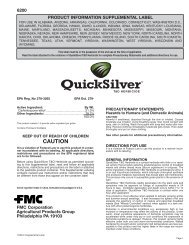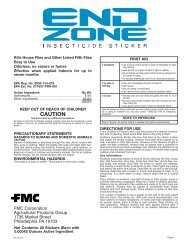Blindside Herbicide 10-19-10 Commercial Label - FMC Professional ...
Blindside Herbicide 10-19-10 Commercial Label - FMC Professional ...
Blindside Herbicide 10-19-10 Commercial Label - FMC Professional ...
You also want an ePaper? Increase the reach of your titles
YUMPU automatically turns print PDFs into web optimized ePapers that Google loves.
For Selective Weed Control in Turf Including<br />
Residential, <strong>Commercial</strong> and Institutional Lawns,<br />
Athletic Fields, <strong>Commercial</strong> Sod Farms, Golf<br />
Courses (Fairways and Roughs), and Other Noncrop<br />
Sites<br />
EPA Reg. No. 279-3411 EPA Est. No. 279-IL-1<br />
Active Ingredients:<br />
By Wt.<br />
Sulfentrazone* ....................................................60.00%<br />
Metsulfuron-methyl* ..............................................6.00%<br />
Other Ingredients: ................................................ 34.00%<br />
Total: <strong>10</strong>0.0%<br />
*<strong>Blindside</strong> <strong>Herbicide</strong> contains 0.66 pounds of active ingredient per one pound of<br />
product.<br />
U.S. Patent No. Pending<br />
KEEP OUT OF REACH OF CHILDREN<br />
CAUTION<br />
See other panels for additional precautionary information.<br />
<strong>FMC</strong> Corporation<br />
Agricultural Products Group<br />
1735 Market Street<br />
Philadelphia PA <strong>19</strong><strong>10</strong>3<br />
Net Weight: 0.5 Pounds<br />
<strong>10</strong>-<strong>19</strong>-<strong>10</strong><br />
IF SWALLOWED<br />
IF IN EYES<br />
IF ON SKIN OR<br />
CLOTHING<br />
IF INHALED<br />
FIRST AID<br />
• Call a poison control center or doctor immediately for treatment<br />
advice<br />
• Have person sip a glass of water if able to swallow.<br />
• Do not induce vomiting unless told to do so by the poison<br />
control center or doctor.<br />
• Do not give anything by mouth to an unconscious person.<br />
• Hold eye open and rinse slowly and gently with water for 15-<br />
20 minutes.<br />
• Remove contact lenses, if present, after the first 5 minutes,<br />
then continue rinsing eye.<br />
• Call a poison control center or doctor for treatment advice.<br />
• Take off contaminated clothing.<br />
• Rinse skin immediately with plenty of water for 15-20 minutes.<br />
• Call a poison control center or doctor for treatment advice.<br />
• Move person to fresh air.<br />
• If person is not breathing, call 911 or an ambulance, then<br />
give artificial respiration, preferably by mouth-to-mouth, if<br />
possible.<br />
• Call a poison control center or doctor for further treatment<br />
advice.<br />
HOTLINE NUMBER<br />
Have the product container or label with you when calling a poison control center or doctor,<br />
or going for treatment. You may also contact 1-800-331-3148 for emergency medical<br />
treatment information.<br />
For Information Regarding the Use of this Product Call 1-800-321-1<strong>FMC</strong>(1362).<br />
PRECAUTIONARY STATEMENTS<br />
Hazards to Humans (and Domestic Animals)<br />
CAUTION<br />
Harmful if swallowed. Causes moderate eye irritation. Avoid contact with<br />
eyes or clothing.<br />
Personal Protective Equipment (PPE)<br />
Applicators and other handlers must wear: long-sleeved shirt and long<br />
pants, waterproof gloves, and shoes plus socks.<br />
Discard clothing and other absorbent materials that have been<br />
drenched or heavily contaminated with this product. Do not reuse them.<br />
Follow manufacturerʼs instructions for cleaning/maintaining PPE. If no<br />
such instructions for washables, use detergent and hot water. Keep and<br />
wash PPE separately from other laundry.<br />
User Safety Recommendations:<br />
Users should:<br />
• Wash thoroughly with soap and water after handling and before eating,<br />
drinking, chewing gum, using tobacco or using the toilet.<br />
Environmental Hazards<br />
This pesticide is toxic to marine/estuarine invertebrates. Do not apply<br />
directly to water, to areas where surface water is present or to intertidal<br />
areas below the mean high water mark. Drift and runoff may be hazardous<br />
to terrestrial and aquatic plants in neighboring areas. Do not<br />
contaminate water when disposing of equipment washwaters or rinsate.<br />
Groundwater Advisory: The active ingredients in this product are<br />
known to leach through soil into groundwater under certain conditions<br />
as a result of label use. Use of this chemical in areas where soils are<br />
permeable, particularly where the water table is shallow, may result in<br />
groundwater contamination.<br />
Do not use on coarse soils classified as sand which have less than 1%<br />
organic matter.<br />
Page 1
Surface Water Advisory: <strong>Blindside</strong> <strong>Herbicide</strong> can contaminate surface<br />
water through spray drift. Under some conditions, <strong>Blindside</strong> <strong>Herbicide</strong><br />
may also have a high potential for runoff into surface water (primarily via<br />
dissolution in runoff water), for several to many months post-application.<br />
These include poorly draining or wet soils with readily visible slopes<br />
toward adjacent surface waters, frequently flooded areas, areas overlying<br />
extremely shallow groundwater, areas with in-field canals or ditches<br />
that drain to surface water, areas not separated from adjacent surface<br />
waters with vegetated filter strips, and areas over-lying tile drainage<br />
systems that drain to surface waters.<br />
DIRECTIONS FOR USE<br />
It is a violation of Federal Law to use this product in a manner inconsistent<br />
with its labeling.<br />
Do not apply this product through any type of irrigation system.<br />
Do not apply this product in a way that will contact workers or other persons,<br />
either directly or through drift. Only protected handlers may be in<br />
the area during application. For any requirements specific to your state<br />
or tribe, consult the agency responsible for pesticide regulation.<br />
AGRICULTURAL USE REQUIREMENTS<br />
Use this product only in accordance with its labeling and with the<br />
Worker Protection Standard, 40 CFR part 170. This standard contains<br />
requirements for the protection of agricultural workers on farms,<br />
forests, nurseries, and greenhouses, and handlers of agricultural<br />
pesticides. It contains requirements for training, decontamination,<br />
notification, and emergency assistance. It also contains specific<br />
instructions and exceptions pertaining to the statements on this label<br />
about personal protective equipment (PPE), notification to workers,<br />
and restricted-entry interval. The requirements in this box apply to<br />
uses of this product that are covered by the Worker Protection<br />
Standard.<br />
Do not enter or allow worker entry into treated areas during the<br />
restricted entry interval (REI) of 12 hours.<br />
PPE required for early entry to treated areas that is permitted under<br />
the Worker Protection Standard and that involves contact with anything<br />
that has been treated, such as plants, soil, or water, is:<br />
• coveralls over long-sleeved shirt and long pants.<br />
• chemical-resistant gloves made of any waterproof material.<br />
• shoes plus socks.<br />
Non-Agricultural Use Requirements<br />
The requirements in this box apply to uses of this product that are<br />
NOT within the scope of the Worker Protection Standard for agricultural<br />
pesticides (40 CFR Part 170). The WPS applies when this product<br />
is used to produce agricultural plants on farms, forests, nurseries,<br />
or greenhouses.<br />
Re-entry Statement: Do not allow people (other than applicator) or<br />
pets on treatment area during application. Do not enter treatment<br />
area until spray has dried.<br />
STORAGE AND DISPOSAL<br />
Do not contaminate water, food of feed by storage or disposal.<br />
Pesticide Storage<br />
Store product in original container only, away from other pesticides,<br />
fertilizer, food or feed.<br />
Store in a cool, dry place and avoid excess heat.<br />
In case of spill, avoid contact, isolate area and keep out animals and<br />
unprotected persons. Confine spills. Call CHEMTREC<br />
(Transportation and spills): (800) 424-9300.<br />
To confine spill: If liquid, dike surrounding area or absorb with sand,<br />
cat litter or commercial clay. If dry material, cover to prevent dispersal.<br />
Place damaged package in a holding container. Identify contents.<br />
Pesticide Disposal<br />
If these wastes cannot be disposed of by use according to label<br />
instructions, contact your State Pesticide or Environmental Control<br />
Agency or the Hazardous Waste representative at the nearest EPA<br />
Regional office for guidance.<br />
Container Disposal<br />
Metal or Plastic Containers: - Nonrefillable container. Do not<br />
reuse or refill this container. Triple rinse container (or equivalent)<br />
promptly after emptying. Triple rinse as follows: (For containers<br />
greater than 5 gallons) Empty the remaining contents into application<br />
equipment or a mix tank. Fill the container 1/4 full with water.<br />
Replace and tighten closures. Tip container on its side and roll it back<br />
and forth, ensuring at least one complete revolution, for 30 seconds.<br />
Stand the container on its end and tip it back and forth several times.<br />
Empty the rinsate into application equipment or a mix tank or store<br />
rinsate for later use or disposal. Repeat this procedure two more<br />
times. (For containers 5 gallons or less) empty the remaining contents<br />
into application equipment or a mix tank and drain for <strong>10</strong> seconds<br />
after the flow begins to drip. Fill the container 1/4 full with water<br />
and recap. Shake for <strong>10</strong> seconds. Pour rinsate into application equipment<br />
or a mix tank store rinsate for later use or disposal. Drain for <strong>10</strong><br />
seconds after the flow begins to drip. Repeat this procedure two<br />
more times.<br />
Then offer for recycling if available, or reconditioning, or if approved<br />
by state and local authorities, puncture and dispose of in sanitary<br />
landfill, or by other procedures. Do not cut or weld or cut metal containers.<br />
Returnable/Refillable containers: - Refill this container with pesticide<br />
only. Do not reuse this container for any other purpose. Cleaning the<br />
container before final disposal is the responsibility of the person disposing<br />
of the container. Cleaning before refilling is the responsibility<br />
of the refiller. To clean the container before final disposal, empty the<br />
remaining contents into application equipment or mix tank. Fill the<br />
container about <strong>10</strong>% full with water. Agitate vigorously or recirculate<br />
water with the pump for 2 minutes. Pour or pump rinsate into the<br />
application equipment or rinsate collection system. Repeat this rinsing<br />
procedure two more times.<br />
Turf Use Instructions<br />
Product Information<br />
<strong>Blindside</strong> <strong>Herbicide</strong> is a selective post- emergence herbicide which controls<br />
annual grasses, broadleaf weeds and sedges in established turf<br />
areas including, but not limited to, residential, commercial and institutional<br />
lawns, athletic fields, commercial sod farms, golf course fairways<br />
and golf course roughs.<br />
<strong>Blindside</strong> <strong>Herbicide</strong> is formulated as a WDG (Water Dispersible<br />
Granule) containing 0.66 lb of active ingredient per pound of product.<br />
<strong>Blindside</strong> <strong>Herbicide</strong> is absorbed by shoots, foliage and roots.<br />
A post emergent application of <strong>Blindside</strong> <strong>Herbicide</strong> is improved when<br />
adequate soil moisture is present at application. Best weed control<br />
results will be obtained when no rainfall or irrigation occurs within 24<br />
hours after application. If no rainfall or irrigation occurs within 7 days<br />
after application of <strong>Blindside</strong> <strong>Herbicide</strong> in the amount of 0.5 inches, then<br />
irrigation of at least 0.5 inches is recommended.<br />
Mixing and Application Instructions<br />
Product handling instructions<br />
This product may not be mixed or loaded within 50 feet of any wells<br />
(including abandoned wells and drainage wells), sink holes, perennial or<br />
intermittent streams and rivers, and natural or impounded lakes and<br />
reservoirs. This setback does not apply to properly capped or plugged<br />
abandoned wells and does not apply to impervious pad or properly<br />
diked mixing/loading areas.<br />
Operations that involve mixing, loading, rinsing or washing of this product<br />
into or from pesticide handling or application equipment or containers<br />
within 50 feet of any well, are prohibited unless conducted on an<br />
impervious pad constructed to withstand the weight of the heaviest load<br />
that may be positioned on or moved across the pad. Such a pad shall<br />
be designed and maintained to contain any product spills or equipment<br />
leaks, container or equipment rinse or wash water, and rainwater that<br />
may fall on the pad. Surface water shall not be allowed to either flow<br />
over or from the pad, which means the pad must be self contained. The<br />
pad shall be sloped to facilitate material removal. An unroofed pad shall<br />
be of sufficient capacity to contain at a minimum 1<strong>10</strong>% of the capacity<br />
Page 2
of the largest pesticide container or application equipment on the pad.<br />
A pad that is covered by a roof of sufficient size to completely exclude<br />
precipitation from contact with the pad shall have a minimum containment<br />
capacity of <strong>10</strong>0% of the capacity of the largest pesticide container<br />
or application equipment on the pad. Containment capacities as<br />
described above shall be maintained at all times. The above specific<br />
minimum containment capacities do not apply to vehicles when delivering<br />
pesticide shipments to the mixing/loading site. States may have in<br />
effect additional requirements regarding wellhead setbacks and operational<br />
containment.<br />
Product must be used in a manner which will prevent back siphoning in<br />
wells, spills or improper disposal of excess pesticide, spray mixtures or<br />
rinsates.<br />
SPRAY TANK PREPARATION<br />
It is important that spray equipment is clean and free of existing pesticide<br />
deposits before using this product. Follow the spray tank clean out<br />
procedures specified on the label of product previously applied before<br />
adding <strong>Blindside</strong> <strong>Herbicide</strong> to the tank.<br />
<strong>Blindside</strong> <strong>Herbicide</strong> is a water dispersible granule intended for dilution<br />
with water. Mix <strong>Blindside</strong> <strong>Herbicide</strong> thoroughly and continue agitation<br />
during application. If <strong>Blindside</strong> <strong>Herbicide</strong> is left standing for extended<br />
period of time in spray tank, re-agitate to assure uniform suspension of<br />
product in spray mixture.<br />
MIXING WITH WATER<br />
For best results, fill spray tank with one fourth of the volume of clean<br />
water needed for the area to be treated. Start the agitation system and<br />
add <strong>Blindside</strong> <strong>Herbicide</strong> to the tank. Make sure <strong>Blindside</strong> <strong>Herbicide</strong> is<br />
thoroughly mixed before application or before adding another product to<br />
the spray tank.<br />
USE OF SURFACTANTS<br />
Temporary discoloration of some turf types may result from use of<br />
surfactants or adjuvants with <strong>Blindside</strong> <strong>Herbicide</strong>. High temperatures<br />
and high relative humidity may increase the risk of temporary<br />
discolorations not recommended.<br />
TANK MIXTURES COMPATIBILITY<br />
<strong>Blindside</strong> <strong>Herbicide</strong> has been found to be compatible with most herbicides,<br />
fungicides, insecticides and growth regulators commonly used in<br />
turf and ornamental plant management. However, when preparing a<br />
new tank mix conduct an appropriate compatibility test by mixing proportional<br />
amounts of all spray ingredients in a test vessel (jar) prior to<br />
tank mixing with other products. Shake the mixture vigorously and<br />
allow it to stand for five to ten minutes. Rapid precipitation of the<br />
ingredients and failure to re-suspend when shaken indicates that the<br />
mixture is incompatible and should not be applied. Provided the jar test<br />
indicates the mixture to be compatible, prepare the tank mixture as follows:<br />
Fill the tank one fourth full with water. With the agitator operating,<br />
add the recommended amounts of ingredients using the following order:<br />
dry granules first, then liquid suspensions (flowables) second. As the<br />
agitation continues and the tank is filled with water add EC products<br />
third followed by the addition of water soluble products.<br />
Read and observe mixing instructions of all tank mix partners. Also read<br />
each product label for Directions for Use, Precautionary Statements and<br />
Restrictions and Limitations. The most restrictive labeling applies in all<br />
tank mixtures. No label dosage rate should be exceeded. Tank mixture<br />
recommendations are for use only in states where the companion products<br />
and application site are registered. In addition, certain states or<br />
geographical regions may have established dosage rate limitations.<br />
Consult your state Pesticide Control Agency for additional information<br />
regarding the maximum use rates.<br />
Use <strong>Blindside</strong> <strong>Herbicide</strong> spray mixture immediately after mixing. Do not<br />
store the mixture.<br />
Ground Equipment<br />
Power sprayers: Uniform and accurate spray coverage requires proper<br />
calibration, agitation and operation of spray equipment. The use of<br />
marker dyes or foams can improve application accuracy. Boom<br />
sprayers equipped with appropriate flat fan nozzles, tips and screens<br />
are ideal for broadcast applications. Power sprayers fitted with spray<br />
wand/gun may also be used for broadcast application after careful calibration<br />
by the applicator. Power sprayers fitted with spray wand/gun are<br />
suitable for spot treatments.<br />
Hand operated sprayers: Backpack and compression sprayers are<br />
appropriate for small turfgrass areas and spot treatments. Wands fitted<br />
with a flat fan nozzle tip should be held stationary at the proper height<br />
during application. A side to side or swinging arm motion can result in<br />
uneven coverage.<br />
Apply this product in a sufficient volume of carrier solution to provide a<br />
uniform spray distribution. Spray volumes of 20 – 175 gallons per acre<br />
(0.5 to 4.0 gal/1,000 ft2) with spray pressures adjusted to 20 – 40 psi<br />
are appropriate. Apply the higher spray volumes for dense weed populations.<br />
Sprayer Equipment Clean-Out<br />
After spraying <strong>Blindside</strong> <strong>Herbicide</strong> and before using sprayer equipment<br />
for any other applications, the sprayer must be thoroughly<br />
cleaned using the following procedure:<br />
1. Drain sprayer tank, hoses, and spray boom and thoroughly rinse the<br />
inside of the sprayer tank with clean water to remove sediment and<br />
residues. In addition, thoroughly flush sprayer hoses, boom, and nozzles<br />
with clean water.<br />
2. Fill the tank 1/2 full with clean water, and add appropriate detergent<br />
or ammonia (follow manufacturerʼs directions for use). Fill the tank to<br />
capacity and operate the sprayer for 15 minutes to flush hoses, boom,<br />
and nozzles.<br />
3. Drain the sprayer system. Rinse the tank with clean water and flush<br />
through the hoses, boom, and nozzles. Remove and clean spray tips<br />
and screens separately.<br />
4. Properly dispose of all cleaning solution and rinsate in accordance<br />
with Federal, State and local regulations and guidelines.<br />
Do not drain or flush equipment on or near desirable trees or plants. Do<br />
not contaminate any body of water including irrigation water that may be<br />
used on other plants.<br />
Weed Control in Turfgrass<br />
Use Precautions for Turf Use<br />
Turfgrass Safety<br />
This product may be used on seeded, sodded or sprigged turfgrass that<br />
are well established. First application of this product can be made following<br />
the second mowing providing the turfgrass has developed into a<br />
uniform stand with a good root system. Turfgrass injury could result from<br />
application of this product on turfgrass that is not well established or has<br />
been weakened by stresses such as unfavorable weather conditions,<br />
disease, chemical or mechanical influences.<br />
Table 1. Tolerant grasses.<br />
Grass Type*<br />
Cool Season Grasses<br />
Bluegrass, Kentucky (Poa pratensis)<br />
Fescue, tall (Festuca arundinacea)<br />
Warm Season Grasses<br />
Bermudagrass (Cynodon dactylon) & hybrids<br />
Centipedegrass (Eremochloa ophuiroides)<br />
St.Augustine grass (Stenotaphrum secundatum)<br />
Zoysiagrass (Zoysia japonica)<br />
Recommended Use Rate<br />
Single application<br />
Ounces per Ounces per<br />
<strong>10</strong>00 ft 2 acre<br />
0.075 - 0.14<br />
lbs. ai/A<br />
3.25 - 6.5 0.134 - 0.269<br />
0.149 - 0.23 6.5 - <strong>10</strong> 0.269 - 0.413<br />
*<strong>Blindside</strong> <strong>Herbicide</strong> has demonstrated tolerance on both cool and warm season<br />
turfgrasses. However, not all varieties have been evaluated. Turfgrass managers<br />
desiring to treat newly released varieties should first apply <strong>Blindside</strong> <strong>Herbicide</strong> to<br />
a small area prior to treatment of larger areas.<br />
If turf discoloration occurs after an application of <strong>Blindside</strong> <strong>Herbicide</strong> turfgrass will<br />
generally recover with new growth. Discolored leaf tissue will be removed with<br />
mowing. To reduce potential for discoloration, do not apply <strong>Blindside</strong> <strong>Herbicide</strong> on<br />
turfgrass that is weakened by weather, mechanical, chemical, disease or other<br />
related stress. Maintain proper cultural practices such as adequate moisture and<br />
fertility levels to promote healthy turf growth.<br />
Application to reseeded, overseeded or sprigged areas:<br />
Reseeding, overseeding or sprigging of treated areas within one (1)<br />
month after application of this product could inhibit the establishment of<br />
desirable turfgrasses. A spring application of <strong>Blindside</strong> <strong>Herbicide</strong> may<br />
aid in overseeded ryegrass transition in Bermudagrass, transition efficacy<br />
may be species depentent. Overseeding of bermudagrass with<br />
perennial ryegrass at six (6) to eight (8) weeks after an application can<br />
be done if slight injury to perennial ryegrass can be tolerated. Best<br />
results are obtained for reseeding or overseeding when mechanical or<br />
power seeding equipment (slit seeders) are used to give good seed to<br />
soil contact and proper soil cultivation, irrigation and fertilization practices<br />
are followed.<br />
Sod Production:<br />
This product may be applied to established sod. Allow sod to establish<br />
a good root system, a uniform stand and to fill in the exposed edges. It<br />
is recommended that sod be established for up to three (3) months<br />
before an application of <strong>Blindside</strong> <strong>Herbicide</strong>. Do not apply this product<br />
within three (3) months of harvest.<br />
Restrictions and Other Use Precautions:<br />
Do not apply to golf course putting greens, collars or tees.<br />
Do not use on turfgrass other than those listed on this label.<br />
Do not apply to turfgrass under stress.<br />
Do not apply with surfactants unless previous experience has demonstrated<br />
combinations with surfactant to be physically compatible and<br />
non-injurious to the grass type in question.<br />
Do not treat pastures, rangeland, or other areas grazed or harvested for<br />
livestock forage or hay.<br />
Do not apply directly to landscape ornamentals or ornamental beds.<br />
Do not allow spray drift to contact landscape ornamentals, shrubs and<br />
trees.<br />
Temporary turfgrass discoloration has been observed when trinexapacethyl<br />
products have been either tank-mixed or applied within 7 days of<br />
a <strong>Blindside</strong> <strong>Herbicide</strong> application. It is recommended that trinexapacethyl<br />
applications be made 7 days prior to, or after <strong>Blindside</strong> <strong>Herbicide</strong><br />
application to reduce risk of turfgrass discoloration.<br />
Page 3
Do not use clippings as mulch or compost around flowers, ornamentals,<br />
trees or in vegetable gardens.<br />
Do not plant in treated areas with shrubs and trees for one year after<br />
application. Beddings should be planted in treated areas for two years<br />
following application.<br />
POSTEMERGENCE CONTROL OF GRASS AND BROADLEAF<br />
WEEDS<br />
When used as directed <strong>Blindside</strong> <strong>Herbicide</strong> will control or suppress the<br />
weeds listed in Table 2 when applied alone shortly after weeds have<br />
emerged.<br />
Do not exceed the application rate specified for the turfgrass species in<br />
Table 1.<br />
Table 2. Weeds Controlled or Suppressed by <strong>Blindside</strong> <strong>Herbicide</strong><br />
Common Name<br />
Scientific Name<br />
Control Suppress<br />
Bittercress<br />
(Cardamine spp.)<br />
X<br />
Barnyardgrass<br />
(Echinochloa crusgalli)<br />
X<br />
Black medic<br />
(Medicago lupulina)<br />
X<br />
Buttercups<br />
(Ranunculus spp.)<br />
X<br />
Buttonweed, Virginia<br />
Diodia Virginiana<br />
X<br />
Carolina geranium<br />
Carpetweed<br />
Chickweed, common<br />
Chickweed, mousear<br />
Cinquefoil<br />
Clover<br />
Crabgrass (Large and Smooth)<br />
Creeping Beggarweed<br />
Crown Vetch<br />
Cudweed<br />
Dandelion<br />
Dock, Curly<br />
Dogfennel<br />
Dollarweed<br />
Doveweed 1<br />
Eclipta<br />
Evening primrose<br />
Fiddleneck<br />
Filaree<br />
Foxtail spp.<br />
Groundsel<br />
Goldenrod<br />
Ground ivy<br />
Henbit<br />
Japanese Stiltgrass<br />
Knotweed, prostrate<br />
Kochia<br />
Kyllinga, green<br />
Kyllinga, False green<br />
Lambsquarters, common<br />
Lawn burweed<br />
Lespedeza, common<br />
London Rocket<br />
Mallow, common<br />
Miner Lettuce<br />
Morningglory<br />
Mustard, Tansy<br />
Mustard, Tumble<br />
Nutsedge, Yellow<br />
Parsley piert<br />
Pigweed, Redroot<br />
Pigweed, Smooth<br />
Pigweed, Tumble<br />
Pineapple weed<br />
Plantain, broadleaf<br />
Plantain, buckhorn<br />
Prickly Lettuce<br />
Puncture weed<br />
Purslane, common<br />
Pusley, Florida<br />
Sedge, Globe<br />
Sedge, annual<br />
Shepardspurse<br />
Smartweed, Pennsylvania<br />
Sorrel, Red<br />
Speedwell<br />
Spurge, (annuals)<br />
(Geranium carolinianum)<br />
(Mollugo verticillata)<br />
(Stellaria media)<br />
(Cerastium vulgatum)<br />
(Potentilla spp.)<br />
(Trifolium spp.)<br />
(Digitaria spp.)<br />
Desmodium canum<br />
( Vicia sativa l. )<br />
(Gnaphalium spp.)<br />
(Taraxacum officinale)<br />
(Rumex crispus)<br />
(Eupatorium capillifolium(Lam.) Small<br />
(Hydrocotyle spp.)<br />
(Murdannia nudiflora(L. )Brenan<br />
(Eclipta prostrata (L.))<br />
(Oenothera biennis)<br />
(Amsinckia spp.)<br />
(Erodium spp.)<br />
(Setaria spp)<br />
(Senecio smallii Britt.)<br />
(Solidago spp.)<br />
(Glechema hederacea)<br />
(Lamium amplexicaule)<br />
(Microstegium vimineum)<br />
(Polygonum aviculare)<br />
(Kochia scoparia)<br />
(Kyllinga brevifolia Rottb.)<br />
(Kyllinga gracillima Miq.)<br />
(Chenopodium album)<br />
(Soliva pterosperma)<br />
(Lespedeza striata)<br />
(Sisybrium irio)<br />
(Malva neglecta)<br />
(Claytonia perfoliata)<br />
( Ipomea spp.)<br />
(Descurainia pinnata brachycarpa)<br />
(Sisymbrium altissimum L.,)<br />
(Cyperus esculentus)<br />
(Alchemilla arvensis)<br />
(Amaranthus retroflexus)<br />
(Amaranthus hybridus)<br />
(Amaranthus albus)<br />
(Matricaria matricarioides)<br />
(Plantago major)<br />
(Plantago lanceolata)<br />
(Lactuca serriola)<br />
(Tribulus terrestris)<br />
(Portulaca oleracea)<br />
(Richardia scabra)<br />
(Cyperus croceus Vahl)<br />
(Cyperus compreeus L.)<br />
(Capsella bursa pastoris)<br />
(Polygonum pensylvanicum)<br />
(Rumex acetosella)<br />
(Veronica spp.)<br />
(Euphorbia spp.)<br />
X<br />
X<br />
X<br />
X<br />
X<br />
X<br />
X<br />
X<br />
X<br />
X<br />
X<br />
X<br />
X<br />
X<br />
X<br />
X<br />
X<br />
X<br />
X<br />
X<br />
X<br />
X<br />
X<br />
X<br />
X<br />
X<br />
X<br />
X<br />
X<br />
X<br />
X<br />
X<br />
X<br />
X<br />
X<br />
X<br />
X<br />
X<br />
X<br />
X<br />
X<br />
X<br />
X<br />
X<br />
X<br />
X<br />
X<br />
X<br />
X<br />
X<br />
X<br />
X<br />
X<br />
X<br />
X<br />
X<br />
X<br />
Table 2. (Continued)<br />
Common Name<br />
Spurge, prostrate<br />
Spurge, spotted<br />
Star of Bethlehem<br />
Violet, wild<br />
Wild garlic<br />
Wild onion<br />
Woodsorrel, creeping<br />
Woodsorrel, yellow<br />
Scientific Name<br />
(Euphorbia humistrata)<br />
(Euphorbia maculata)<br />
(Ornithogalum umbellatum)<br />
(Viola pratincola)<br />
(Allium vineale)<br />
(Allium canadense)<br />
(Oxalis corniculata )<br />
(Oxalis stricta)<br />
Controlled Suppressed<br />
X<br />
X<br />
X<br />
X<br />
X<br />
X<br />
X<br />
X<br />
1. Two applications of <strong>Blindside</strong> <strong>Herbicide</strong> 14 to 20 days apart may<br />
increase control of doveweed over a single application.<br />
POSTEMERGENCE CONTROL OF ANNUAL AND PERENNIAL<br />
SEDGES<br />
<strong>Blindside</strong> <strong>Herbicide</strong> will control or suppress sedges (Table 3). Apply the<br />
highest rate consistent with the rate needed for turfgrass safety in Table<br />
1.<br />
Good spray coverage is needed for optimum control of sedges.<br />
Temporary discoloration of some turfgrass species may result from use<br />
of surfactant. Use of surfactants is not recommended.<br />
Table 3. Sedge species controlled or suppressed by <strong>Blindside</strong><br />
<strong>Herbicide</strong><br />
Common Name<br />
Scientific Name<br />
Kyllinga, green<br />
(Kyllinga brevifolia)<br />
Kyllinga, false green<br />
(Kyllinga gracillima)<br />
Nutsedge, yellow<br />
(Cyperus esculentus)<br />
Sedge, globe<br />
(Cyperus globulosus)<br />
Sedge, cylindric<br />
(Cyperus retrorsus)<br />
Conditions of Sale and Limitation of Warranty and<br />
Liability:<br />
NOTICE: Read the entire Directions for Use and Conditions of Sale<br />
and Limitation of Warranty and Liability before buying or using this<br />
product. If the terms are not acceptable, return the product at once,<br />
unopened, and the purchase price will be refunded.<br />
The Directions for Use of this product must be followed carefully. It is<br />
impossible to eliminate all risks inherently associated with the use of this<br />
product. Crop injury, ineffectiveness, or other unintended consequences<br />
may result because of such factors as manner of use or application,<br />
weather or crop conditions beyond the control or <strong>FMC</strong> or Seller. All<br />
such risks shall be assumed by Buyer and User, and Buyer and User<br />
agree to hold <strong>FMC</strong> and Seller harmless for any claims relating to such<br />
factors.<br />
Seller warrants that this product conforms to the chemical description<br />
on the label and is reasonably fit for the purposes stated on the<br />
Directions for Use when used in accordance with the directions under<br />
normal conditions of use. TO THE EXTENT CONSISTENT WITH<br />
APPLICABLE LAW, <strong>FMC</strong> MAKES NO WARRANTIES OF MER-<br />
CHANTABILITY OR OF FITNESS FOR A PARTICULAR PURPOSE,<br />
NOR ANY OTHER EXPRESS OR IMPLIED WARRANTIES WITH<br />
RESPECT TO THE SELECTION, PURCHASE, OR USE OF THIS<br />
PRODUCT. Any warranties, express or implied, having been made are<br />
inapplicable if this product has been used contrary to label instructions,<br />
or under abnormal conditions, or under conditions not reasonably foreseeable<br />
to (or beyond the control of) seller or <strong>FMC</strong>, and buyer assumes<br />
the risk of any such use.<br />
To the extent consistent with applicable law, <strong>FMC</strong> or seller shall not be<br />
liable for any incidental, consequential or special damages resulting<br />
from the use or handling of this product. TO THE EXTENT CONSIS-<br />
TENT WITH APPLICABLE LAW, THE EXCLUSIVE REMEDY OF THE<br />
USER OR BUYER, AND THE EXCLUSIVE LIABILITY OF <strong>FMC</strong> AND<br />
SELLER FOR ANY AND ALL CLAIMS, LOSSES, INJURIES OR DAM-<br />
AGES (INCLUDING CLAIMS BASED ON BREACH OF WARRANTY,<br />
CONTRACT, NEGLIGENCE, TORT, STRICT LIABILITY OR OTHER-<br />
WISE) RESULTING FROM THE USE OR HANDLING OF THIS PROD-<br />
UCT, SHALL BE THE RETURN OF THE PURCHASE PRICE OF THE<br />
PRODUCT OR, AT THE ELECTION OF <strong>FMC</strong> OR SELLER, THE<br />
REPLACEMENT OF THE PRODUCT.<br />
This Conditions of Sale and Limitation of Warranty and Liability may not<br />
be amended by any oral or written agreement.<br />
<strong>FMC</strong> – Trademark of <strong>FMC</strong> Corporation<br />
© <strong>FMC</strong> Corporation 20<strong>10</strong><br />
0928<strong>10</strong><br />
Page 4


